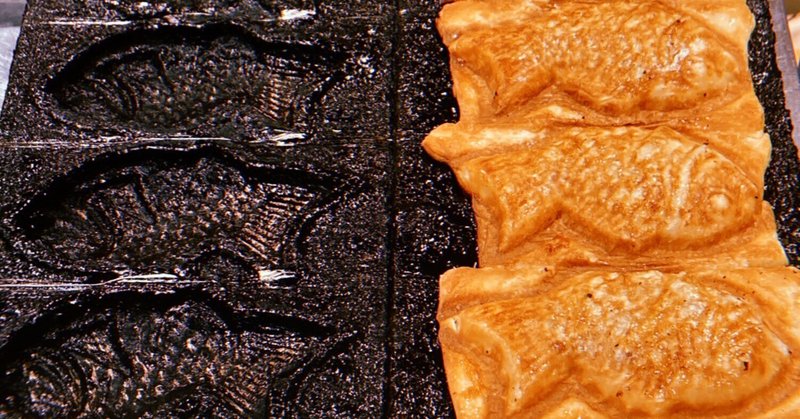
Dig Japan vol.5 “Taiyaki (たい焼き)”
Taiyaki (たい焼き) is wagashi made mainly from wheat flour, filled with azuki bean paste and baked in a metal mold shaped like a sea bream. Since it was first sold in 1909, a variety of fillings, shapes, and sizes have been developed and after the war, it also spread to America and other Asian countries. How was it born?

Basically, taiyaki is said to be a modified form of imagawa-yaki (今川焼き), a snack made by wrapping azuki bean paste in flour and baking it. Regarding its origin, there is a theory that it was made using a casting mold during the Meiji period, and references to taiyaki can already be found in literary works, writings, and newspaper articles from the end of the Meiji period. Regarding the original confectionary shop, it is said to be Naniwaya founded by Seijiro Kobe who was born in Osaka and opened it in 1909 in Kojimachi, Tokyo (the beginning of the current Naniwaya main shop in Azabujuban). The reason for its creation was the poor sales of imagawa-yaki. Although imagawa-yaki itself was widely known, that of sold at Seijiro's shop was not very popular, and sales were sluggish. Therefore, in order to overcome this crisis, he decided to keep the recipe and ingredients of imagawa-yaki the same, but change only the shape.First, he made it into the shape of a turtle, but it didn't sell well. So they changed it into the shape of a sea bream, which was believed to bring good luck in Japan, and promoted it as a lucky confectionery, which became a hit.

Generally, there are two types of taiyaki grilling molds: one that bakes one piece at a time, namely “Itcho-yaki (一丁焼き),” and the other that grills multiple pieces at once on a griddle. Some people call taiyaki differently depending on these grill methods. In this case, the former one is called as “Itcho-yaki” or “Ten'nen-mono (天然物)” which means ‘natural product’ and the latter one is called as “Renshiki (連式)” or “Yoshoku-mono (養殖物)” which means ‘cultured product.’ The use of itcho-yaki molds continues to decline because it requires physical strength to return each mold, which weighs more than 2 kilograms, one by one. However, some taiyaki shops are particular to this traditional method. Similar to imagawa-yaki, taiyaki has a lot of variations such as filled with custard cream, chocolate, caramel, whipped cream, instead of bean paste. Furthermore, some shops sell side dish taiyaki, which is sandwich-like, filled with meat, raw vegetables, sauces. Taiyaki is also sold as frozen food and we can enjoy it warmed in the microwave.
This article was written by 𝐡𝐢𝐫𝐨𝐤𝐨, working as a freelance translator and press for overseas apparel brands in Japan, with the purpose of broadening her insight into the Japanese traditional culture.
いつも読んでくださってありがとうございます☺︎いただいたサポートは、記事のクオリティ向上に活用させていただきます。応援よろしくお願いします❦
